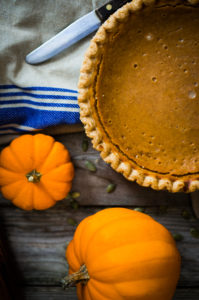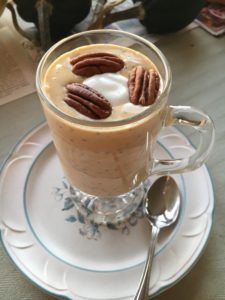





Pumpkin is a powerhouse of mental health nutrients. It is also one of the most versatile vegetables that can be served many different ways. Pumpkin bread, pumpkin ravioli, pumpkin smoothies, pumpkin pie, pumpkin soup, pumpkin risotto, pumpkin beer….there are so many ways to fix pumpkin! Pumpkin is widely available all winter and is very inexpensive. Pumpkins are also easy and fun to grow!
Full disclosure: I love everything that resembles pumpkin pie. I could eat pumpkin pie for every meal and never get tired of it. God bless the person who discovered they could make my coffee taste like pumpkin pie! I hope they made enough money from that discovery to buy their own tropical island. They deserve it.
What’s so good about it?
Pumpkin is high in fiber, which not only aids in digestion, it acts as a prebiotic for healthy gut bacteria. As we learn more about the important connection between gut bacteria and mental health, the more we know how critical it is to have good gut health. Probiotics are beneficial bacteria that strengthen our immune systems and even regulate our moods. Probiotics need fiber in the gut to colonize and flourish. A cup of pumpkin has 3 grams of fiber and only 49 calories. Adding pumpkin to a meal will help you feel full longer.
Pumpkin is a great source of potassium. A cup of pumpkin has about 500 mg of potassium – more than the boastful banana! Potassium is a critical electrolyte that contains a positive electrical charge and works closely with chloride in regulating blood pressure and PH balance. Potassium is necessary for the heart, kidneys, and other organs to work properly. Potassium allows our muscles to move, our nerves to fire, and our kidneys to filter blood. The right balance of potassium literally allows the heart to beat.
Low potassium levels have been associated with greater risk for mood disturbances and depression. Potassium deficiency can cause irritability, fatigue, muscle weakness, cramps, Restless Leg Syndrome, and chronic pain. Depression and pain are intimately intertwined. People with chronic pain have three times the average risk of developing psychiatric symptoms – usually mood or anxiety disorders.
Potassium also helps regulate serotonin, the neurotransmitter that is primarily targeted by antidepressants. Potassium acts as a facilitator in the brain’s ability to utilize serotonin. Potassium’s positive electrical charge is necessary to spark neurotransmitters like serotonin to make us feel better. Even a slight decrease in potassium levels can trigger significant feelings of anxiety. “When levels of serotonin are high, you’re in a better mood, sleep better, and have a higher pain tolerance,” says Elizabeth Somer, MA, RD, author of numerous nutrition books, including her latest, Eat Your Way to Happiness.
Pumpkin is a good source of the amino acids tryptophan, phenylalanine, and tyrosine, all of which are associated with mood-regulating neurotransmitters. Tryptophan converts to serotonin in the brain. While antidepressants attempt to make serotonin more available, tryptophan is the only substance that can make serotonin. Pumpkin seeds are especially high in tryptophan and can be roasted for a delicious snack.
Pumpkin seeds are also high in magnesium. Just half a cup of toasted pumpkin seeds has 92 percent of your daily value of magnesium. Magnesium is nature’s relaxer. Most Americans are deficient in magnesium. Magnesium has long been used to calm nerves and to relax muscles. Its therapeutic role in both depression and anxiety is well documented.
Omega-3 and Omega-6 fatty acids play a very important role in the management of inflammation. Inflammation has been linked to depression and anxiety as well as many other modern diseases and disorders.
Omega-3 fatty acids are anti-inflammatories. They are extremely important for many aspects of health, including mental health.
Omega-6 fatty acids are inflammatory. In other words, they cause inflammation. We need inflammation sometimes. When we have a wound, we need inflammation to protect the wound and promote healing.
Many people are experiencing chronic inflammation, which is detrimental to our physical and mental health. Diseases of chronic inflammation are more prevalent in societies that eat a Western Diet. This is likely due to the high amount of processed food, junk food, and fast food that is full of omega-6 fatty acids from vegetable oils. Oils like soy oil, corn oil, and canola oil are very high in omega-6 fatty acids and very low in omega-3 fatty acids.
The proper ratio of omega-3s to omega-6s is critical for maintaining an inflammation balance. The ideal ratio is 1:1 to as high as 1:4. The Western Diet has a ratio of omega-3s to omega-6s that typically ranges from 1:25 to 1:50! It’s no wonder we suffer from chronic inflammation.
Increasing the omega-3s in our diet while decreasing omega-6s can decrease our risk of depression and anxiety. Many of the foods we eat commonly are high in omega-6s compared to omega-3s. Pumpkin is one of the relative few foods that have the perfect balance of omega-3s to omega-6s in a ratio of 1:1!
How to eat pumpkin
Pumpkin can be baked, boiled, roasted or pureed. It can be made into soups, smoothies, desserts, and casseroles. There are countless recipes online for the myriad ways to eat pumpkin. Pumpkin can also be substituted in almost any recipe calling for other types of winter squash. And don’t forget about the seeds, which can be eaten raw or roasted.
Here is my recipe for Pumpkin Overnight Oats. This recipe is full of mental health nutrients like tryptophan and omega-3s. It’s super easy, healthy, and a great way to start your day with pumpkin!

Pumpkin Overnight Oats
¼ cup regular rolled oats
¼ cup milk, almond milk, or coconut milk
¼ cup Greek yogurt (plain or vanilla)
¼ cup canned or pureed pumpkin
1 Tablespoon chia seeds
1-2 teaspoons maple syrup to taste
¼ teaspoon pumpkin pie spice (recipe below)
Mix together all ingredients or place in a jar and shake until well blended. Leave in the refrigerator overnight and enjoy in the morning garnished with pecans.
Pumpkin Pie Spice
Mix 2 teaspoons cinnamon, 1 teaspoon ginger, and ½ teaspoon cloves until blended. Store in an airtight container.
Had no idea Pumpkin had all these benefits. Great.info thank you
What about just pumpkin on it’s own? Or does it need to be this recipe?
Thanks for the helpful information .
I eat raw pumpkin twice daily.
Thanks to one of my friends who recommended me your blog.
Are pumpkin seeds discouraged due to very high omega 6 content?
Hi Dave,
Most nuts and seeds contain omega 6’s. But, unlike vegetable oils which have little or no redeeming value, they have lots of other nutrients and fiber that make them good choices in moderation. When it comes to omega 6’s, it isn’t so much about the amount we’re consuming as the ratio to omega 3’s. We can, theoretically, eat all of the “good” omega 6’s we want as long as we balance them out by eating enough omega 3’s to equal a 1:1-1:4 ratio.
Hope that helps!